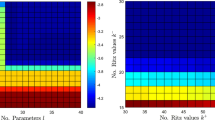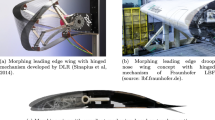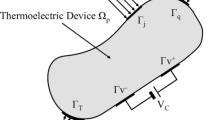Abstract
Electrostatic actuators, actuators actuated by electrostatic forces, are now widely used as sensors and switches, especially in Micro-Electro-Mechanical Systems (MEMS). Among different kinds of electrostatic actuators, the comb drive type is one of the most popular because it has a relatively large range of displacement. In design problems for electrostatic actuators, the driving force profile is of primary engineering importance. In this paper, we develop a structural optimization method for comb drive electrostatic actuators that achieves prescribed driving force profiles, based on a level set-based shape optimization method that provides optimal configurations with clear boundaries, solutions that are valid in an engineering sense. Accurate calculation of the electrostatic forces that occur on the structural boundaries during optimization is important for developing actuators that operate with prescribed driving forces. In the conventional level set-based shape optimization methods, inaccuracies in the calculation of these electrostatic forces occur because the structural boundaries are seldom aligned with the finite element method (FEM) nodes. To precisely calculate the electrostatic forces, we developed a mesh adaptation scheme by which the finite element nodes are brought into alignment with the structural boundaries at every iteration of the optimization procedure. In the following, we explain the details of the proposed level set-based shape optimization method, in which a multi-objective optimization problem is formulated to achieve a prescribed driving force profile. The sensitivity is derived using the adjoint variable method. Four numerical examples are provided, to examine the suitability of the proposed optimization method.











Similar content being viewed by others
References
Allaire G, Jouve F, Toader A (2004) Structural optimization using sensitivity analysis and a level-set method. J Comput Phys 194(1):363–393
Alwan A, Ananthasuresh G (2006a) Coupled electrostatic-elastic analysis for topology optimization using material interpolation. International MEMS Conference 2006. J Phys Conf Ser 34(1):264–270
Alwan A, Ananthasuresh G (2006b) Topology optimization of electrostatically actuated micromechanical structures with accurate electrostatic modeling of the interpolated material model. In: Proceedings of the ASME International Design Engineering Technical Conferences and Computers and Information in Engineering Conferences-2006
Bank RE, Smith RK (1997) Mesh smoothing using a posteriori error estimates. SIAM J Numer Anal 34(3):979–997
Bank RE, Xu J (1996) An algorithm for coarsening unstructured meshes. Numer Math 73(1):1–36
Belytschko T, Black T (1999) Elastic crack growth in finite elements with minimal remeshing. Int J Numer Methods Eng 45(5):601–620
Bendsøe M (1989) Optimal shape design as a material distribution problem. Struct multidiscip Optim 1(4):193–202
Bendsøe M, Sigmund O (1999) Material interpolation schemes in topology optimization. Archive of Appl Mech 69(9):635–654
Bendsøe MP, Kikuchi N (1988) Generating optimal topologies in structural design using a homogenization method. Comput Methods Appl Mech Eng 71(2):197–224
Buell WR, Bush BA (1973) Mesh generation - a survey. J Eng Ind 95(1):332–338
Dolbow J, Belytschko T (1999) A finite element method for crack growth without remeshing. Int J Numer Methods Eng 46(1):131–150
Field DA (1988) Laplacian smoothing and delaunay triangulations. Commun Appl Numer Methods 4(6):709–712
Grade J, Jerman H, Kenny T (2003) Design of large deflection electrostatic actuators. J Microelectromech Syst 12(3):335–343
Hirt C, Amsden A, Cook J (1997) An arbitrary Lagrangian–Eulerian computing method for all flow speeds. J Comput Phys 135(2):203–216
Huerta A, Liu W (1988) Viscous flow with large free surface motion. Comput Methods Appl Mech Eng 69(3):277–324
Kim J, Varadan V, Varadan V, Bao X (1996) Finite-element modeling of a smart cantilever plate and comparison with experiments. Smart Mater Struct 5(2):165–170
Legtenberg R, Groeneveld A, Elwenspoek M (1996) Comb-drive actuators for large displacements. J Micromech Microeng 6(3):320–329
Nemirovsky Y, Bochobza-Degani O (2001) A methodology and model for the pull-in parameters of electrostatic actuators. J Microelectromech Syst 10(4):601–615
Osher S, Fedkiw R (2003) Level Set Methods and Dynamic Implicit Surfaces. Springer-Verlag
Ou K, Chen K, Yang T, Lee S (2011) A novel semianalytical approach for finding pull-in voltages of micro cantilever beams subjected to electrostatic loads and residual stress gradients. J Microelectromech Syst 20(2):527–537
Qian X, Sigmund O (2013) Topological design of electromechanical actuators with robustness toward over-and under-etching. Comput Methods Appl Mech Eng 253:237–251
Raulli M, Maute K (2005) Topology optimization of electrostatically actuated microsystems. Struct multidiscip Optim 30(5):342–359
Seeger J, Boser B (2003) Charge control 812 of parallel-plate, electrostatic actuators and the tip-in instability. J Microelectromech Syst 12(5):656–671
Sethian J (1999) Level set methods and fast marching methods: evolving interfaces in computational geometry, fluid mechanics, computer vision, and materials science, vol 3. Cambridge university press, Cambridge
Sethian J,Wiegmann A (2000) Structural boundary design via level set and immersed interface methods. J comput phys 163(2):489–528
Sukumar N, Chopp D, Moe¨s N, Belytschko T (2001) Modeling holes and inclusions by level sets in the extended finite-element method. Comput Methods Appl Mech Eng 190(46):6183–6200
Sussman M, Smereka P, Osher S (1994) A level set approach for computing solutions to incompressible two-phase flow. Department of Mathematics. University of California, Los Angeles
Wang MY, Wang X, Guo D (2003) A level set method for structural topology optimization. Comput Methods Appl Mech Eng 192(1–2):227–246
Yamada T, Izui K, Nishiwaki S, Takezawa A (2010) A topology optimization method based on the level set method incorporating a fictitious interface energy. Comput Methods Appl Mech Eng 199(45):2876–2891
Yamada T, Izui K, Nishiwaki S (2011) A level set-based topology optimization method for maximizing thermal diffusivity in problems including design-dependent effects. J Mech Des 133(3)
Yamasaki S, Nishiwaki S, Yamada T, Izui K, Yoshimura M (2010) A structural optimization method based on the level set method using a new geometry-based re-initialization scheme. Int J Numer Methods Eng 83(12):1580–1624
Yamasaki S, Nomura T, Kawamoto A, Sato K, Nishiwaki S (2011) A level set-based topology optimization method targeting metallic waveguide design problems. Int J NumerMethods Eng 87(9):844–868
Yang RJ, Chuang CH (1994) Optimal topology design using linear programming. Comput Struct 52(2):265–275
YeW,Mukherjee S (1999) Optimal shape design of three-dimensional mems with applications to electrostatic comb drives. Int J Numer Methods Eng 45(2):175–194
Ye W, Mukherjee S, MacDonald N (1998) Optimal shape design of an electrostatic comb drive in microelectromechanical systems. J Microelectromech Syst 7(1):16–26
Yoon G, Sigmund O (2008) A monolithic approach for topology optimization of electrostatically actuated devices. Comput Methods Appl Mech Eng 197(45–48):4062–4075
Acknowledgments
The first author gratefully acknowledges support from Yushin Precision Equipment Co., Ltd. The third author gratefully acknowledges support from JSPS KAKENHI Grant Number 24760065.
Author information
Authors and Affiliations
Corresponding author
Appendix: Sensitivity Analysis
Appendix: Sensitivity Analysis
The details of the derivation of the sensitivity are now provided. First, the Lagrangian \(\overline {F}\) is rewritten from (29) as follows:
The Lagrangian \(\overline {F}\) changes when the design variable ϕ slightly changes, so we have
Therefore, we have
where a second order variation is neglected. Here, following notations are introduced.
Using the above notations, the first and second terms of the variation δ F can be evaluated as follows:
Here, we recall the Maclaurin expansion with respect to exp(x):
Therefore, we have
Furthermore, we recall the following relationship:
Therefore, we have
Given the boundary condition imposed on Γ q , we have following relationship:
Thus, the boundary integral term can be evaluated as follows:
The variation of \(\overline {F}\) can therefore be evaluated as
To make the terms pertaining to \(\overline {\boldsymbol \delta }(\boldsymbol {\nabla } V^{j})\) and δ q j equivalent to zero, we define the adjoint system as follows:
Then, \(\delta \overline {F}\) can be expressed as
Rights and permissions
About this article
Cite this article
Kotani, T., Yamada, T., Yamasaki, S. et al. Driving force profile design in comb drive electrostatic actuators using a level set-based shape optimization method. Struct Multidisc Optim 51, 369–383 (2015). https://doi.org/10.1007/s00158-014-1130-y
Received:
Revised:
Accepted:
Published:
Issue Date:
DOI: https://doi.org/10.1007/s00158-014-1130-y




